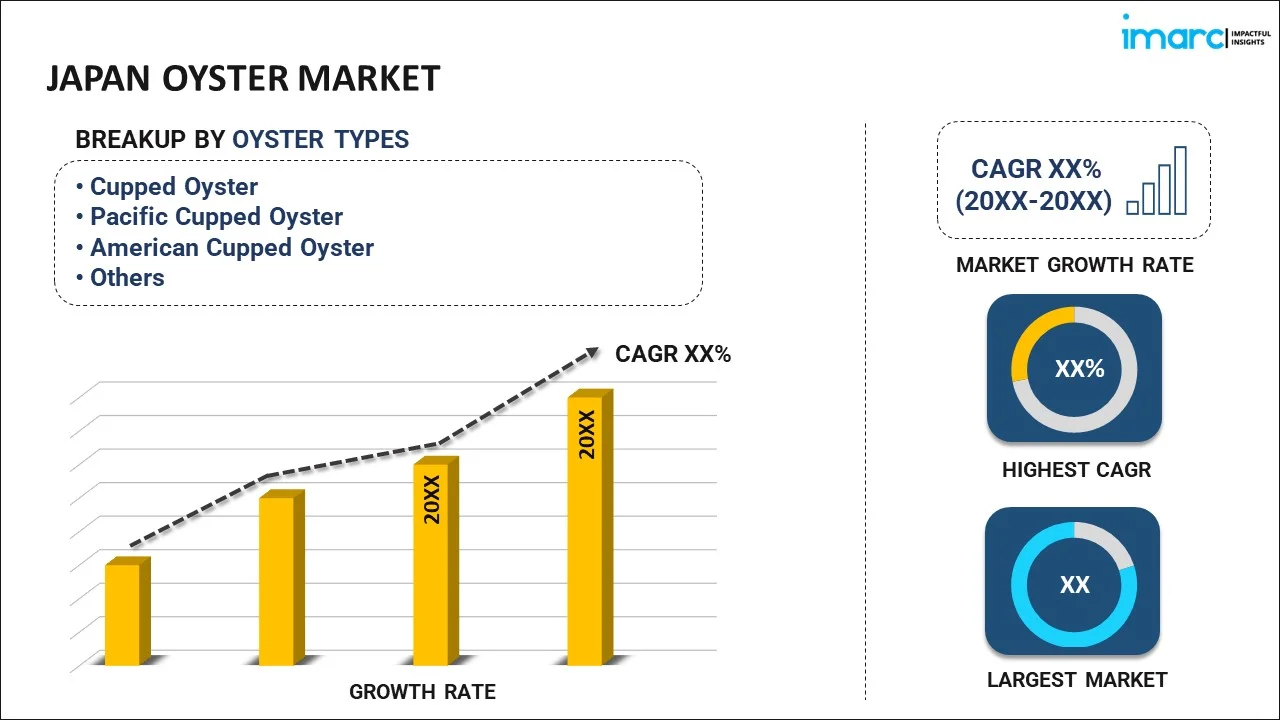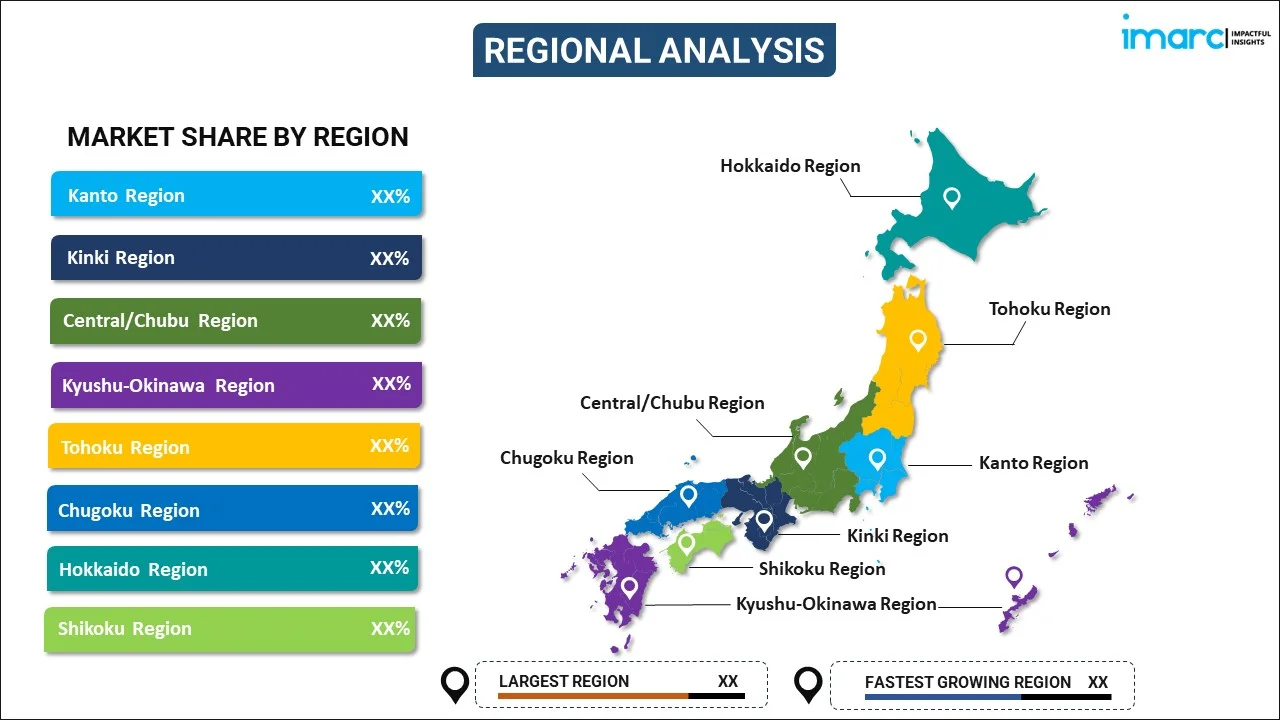
Japan Oyster Market Report by Oyster Type (Cupped Oyster, Pacific Cupped Oyster, American Cupped Oyster, Penguin Wing Oyster, and Others), End User (Foodservice, Retail), Form (Fresh, Frozen, Canned, and Others), and Region 2025-2033
Market Overview:
The Japan oyster market size reached 174.9 Thousand Tons in 2024. Looking forward, IMARC Group expects the market to reach 226.2 Thousand Tons by 2033, exhibiting a growth rate (CAGR) of 2.96% during 2025-2033. The growing popularity of seafood-based dishes among individuals, wide availability of oysters through various distribution channels, such as supermarkets, hypermarkets, and convenience,, specialty, and online stores, and increasing demand for protein-rich diet patterns represent some of the key factors driving the market.
|
Report Attribute
|
Key Statistics
|
|---|---|
|
Base Year
|
2024 |
|
Forecast Years
|
2025-2033 |
|
Historical Years
|
2019-2024
|
| Market Size in 2024 | 174.9 Thousand Tons |
| Market Forecast in 2033 | 226.2 Thousand Tons |
| Market Growth Rate (2025-2033) | 2.96% |
An oyster is a shellfish that belongs to the bivalve mollusks family and has a hard, rough shell and soft and edible flesh inside. It is commonly found in both saltwater and freshwater environments and has a unique flavor, such as briny and savory. It is a rich source of essential nutrients, such as zinc, iron, iodine, selenium, copper, calcium, protein, and vitamins B12, D, B12, and C, and omega-3 fatty acids, such as eicosapentaenoic acid (EPA) and docosahexaenoic acid (DHA). It offers antioxidant and anti-inflammatory effects that help in reducing oxidative stress and inflammation in the body and maintaining overall health. It also provides a balance of nutrients without adding excessive calories to the diet. It assists in maintaining the ecological balance of marine ecosystems by filtering water and improving water quality. It benefits in reducing the risk of numerous cardiovascular diseases, promoting healthy cholesterol levels, and supporting brain function. It is beneficial for individuals who are following a calorie-controlled diet. Besides this, it aids in increasing energy production, maintaining healthy blood cells, and boosting the immune system of individuals. As it is widely consumed both raw and cooked and is incorporated into various dishes, such as stew, soups, and sushi, the demand for oysters is rising in Japan.
Japan Oyster Market Trends/Drivers:
At present, the rising popularity of seafood-based dishes among individuals represents one of the major factors supporting the growth of the market in Japan. Besides this, the increasing adoption of oysters, as they benefit in improving the heart health of individuals, is strengthening the growth of the market in the country. Additionally, there is a rise in the demand for fresh, superior quality, and nutritious oysters among the masses in Japan. This, coupled with the increasing preference for protein-rich diet patterns among individuals, is bolstering the growth of the market. Apart from this, the growing demand for oysters among health-conscious consumers is positively influencing the market in the country. In addition, the wide availability of oysters through various distribution channels, such as supermarkets and hypermarkets, and convenience, specialty and online stores in Japan, is contributing to the growth of the market. Moreover, the increasing number of pubs, clubs, cafes, restaurants, hotels, resorts, and other food service chains in the country is offering lucrative growth opportunities to industry investors. In line with this, the growing demand for oysters on account of the thriving travel and tourism industry is offering a positive market outlook in Japan. Furthermore, the increasing consumer preference for ethically produced and sustainable food options in the country is impelling the growth of the market.
Japan Oyster Industry Segmentation:
IMARC Group provides an analysis of the key trends in each segment of the Japan oyster market report, along with forecasts at the country level for 2025-2033. Our report has categorized the market based on oyster type, end user, and form.
Breakup by Oyster Type:

- Cupped Oyster
- Pacific Cupped Oyster
- American Cupped Oyster
- Penguin Wing Oyster
- Others
The report has provided a detailed breakup and analysis of the market based on the oyster type. This includes cupped oyster, pacific cupped oyster, American cupped oyster, penguin wing oyster, and others. According to the report, cupped oyster represented the largest segment.
Breakup by End User:
- Foodservice
- Retail
- Supermarkets and Hypermarkets
- Convenience Stores
- Specialty Outlets
- Online Channels
- Others
A detailed breakup and analysis of the market based on the end user has also been provided in the report. This includes foodservice and retail (supermarkets and hypermarkets, convenience stores, specialty outlets, online channels, and others). According to the report, retail accounted for the largest market share.
Breakup by Form:
- Fresh
- Frozen
- Canned
- Others
A detailed breakup and analysis of the market based on the form has also been provided in the report. This includes fresh, frozen, canned, and others. According to the report, fresh accounted for the largest market share.
Breakup by Region:

- Kanto Region
- Kinki Region
- Central/ Chubu Region
- Kyushu-Okinawa Region
- Tohoku Region
- Chugoku Region
- Hokkaido Region
- Shikoku Region
The report has also provided a comprehensive analysis of all the major regional markets, which include Kanto Region, Kinki Region, Central or Chubu Region, Kyushu-Okinawa Region, Tohoku Region, Chugoku Region, Hokkaido Region, and Shikoku Region. According to the report, Kanto Region was the largest market for oyster in Japan. Some of the factors driving the Kanto Region oyster market included the growing number of pubs, clubs, cafes, and other food service chains, rising adoption of oysters among health-conscious consumers, increasing preference for ethically produced and sustainable food options, etc.
Competitive Landscape:
The report has also provided a comprehensive analysis of the competitive landscape in the Japan oyster market. Competitive analysis such as market structure, key player positioning, top winning strategies, competitive dashboard, and company evaluation quadrant has been covered in the report. Also, detailed profiles of all major companies have been provided.
Japan Oyster Market Report Scope:
| Report Features | Details |
|---|---|
| Base Year of the Analysis | 2024 |
| Historical Period | 2019-2024 |
| Forecast Period | 2025-2033 |
| Units | Thousand Tons |
| Scope of the Report | Exploration of Historical and Forecast Trends, Industry Catalysts and Challenges, Segment-Wise Historical and Predictive Market Assessment:
|
| Oyster Type Covered | Cupped Oyster, Pacific Cupped Oyster, American Cupped Oyster, Penguin Wing Oyster, Others |
| End Users Covered |
|
| Forms Covered | Fresh, Frozen, Canned, Others |
| Regions Covered | Kanto Region, Kinki Region, Central/ Chubu Region, Kyushu-Okinawa Region, Tohoku Region, Chugoku Region, Hokkaido Region, Shikoku Region |
| Customization Scope | 10% Free Customization |
| Post-Sale Analyst Support | 10-12 Weeks |
| Delivery Format | PDF and Excel through Email (We can also provide the editable version of the report in PPT/Word format on special request) |
Key Questions Answered in This Report:
- How has the Japan oyster market performed so far and how will it perform in the coming years?
- What has been the impact of COVID-19 on the Japan oyster market?
- What is the breakup of the Japan oyster market on the basis of oyster type?
- What is the breakup of the Japan oyster market on the basis of end user?
- What is the breakup of the Japan oyster market on the basis of form?
- What are the various stages in the value chain of the Japan oyster market?
- What are the key driving factors and challenges in the Japan oyster market?
- What is the structure of the Japan oyster market and who are the key players?
- What is the degree of competition in the Japan oyster market?
Key Benefits for Stakeholders:
- IMARC’s report offers a comprehensive quantitative analysis of various market segments, historical and current market trends, market forecasts, and dynamics of the Japan oyster market from 2019-2033.
- The research study provides the latest information on the market drivers, challenges, and opportunities in the Japan oyster market.
- Porter's five forces analysis assist stakeholders in assessing the impact of new entrants, competitive rivalry, supplier power, buyer power, and the threat of substitution. It helps stakeholders to analyze the level of competition within the Japan oyster industry and its attractiveness.
- Competitive landscape allows stakeholders to understand their competitive environment and provides an insight into the current positions of key players in the market.
Need more help?
- Speak to our experienced analysts for insights on the current market scenarios.
- Include additional segments and countries to customize the report as per your requirement.
- Gain an unparalleled competitive advantage in your domain by understanding how to utilize the report and positively impacting your operations and revenue.
- For further assistance, please connect with our analysts.
 Inquire Before Buying
Inquire Before Buying
 Speak to an Analyst
Speak to an Analyst
 Request Brochure
Request Brochure
 Request Customization
Request Customization




.webp)




.webp)












